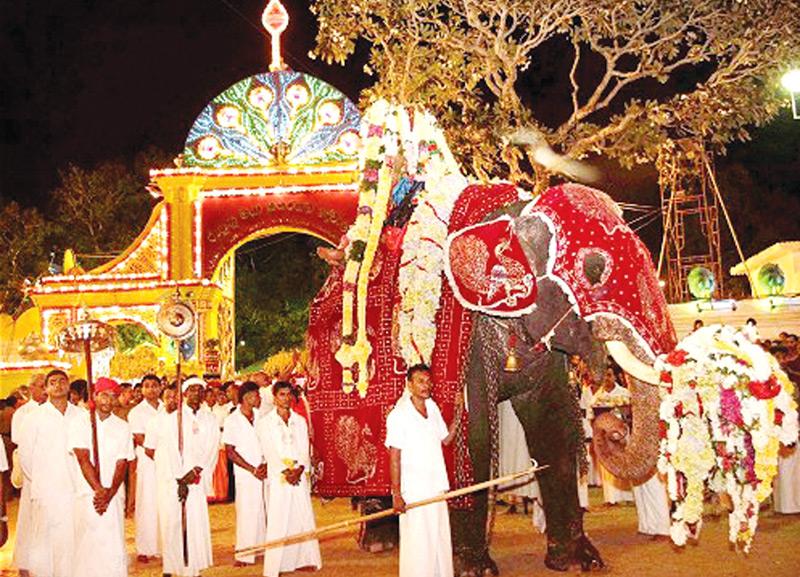
 Not only Buddhists, but also many Hindus believe that the month of Esala belongs to God. This month is significantly important for the Buddhist as the Buddha preached the first sermon during on an Esala full moon Poya Day.
Not only Buddhists, but also many Hindus believe that the month of Esala belongs to God. This month is significantly important for the Buddhist as the Buddha preached the first sermon during on an Esala full moon Poya Day.
Gods
Hindus also hold this belief as every Esala Perahera is held in this month as an offering to the gods.
Thus, the month of Esala (July) is also remembered by the devotees as a month dedicated to the worship of God. Esala festivals are held in almost every major devalaya in Sri Lanka such as Kataragama, Kandy and Devinuwara in an auspicious manner. The main festivals of the Ruhunu Kataragama Maha Devalaya dedicated to the God Sri Skanda of Kataragama are the New Year festivals. Accordingly, the Esala Festival can be considered as the most celebrated of these three festivals.
Tradition
The first part of this festival which is held for nearly 15 days is the Kap Situweema and the Esala Festival is also said to be a tradition that commemorates the marriage of Goddess Valli and God Kataragama.
The first ritual of the Esala Mangalya is Kap Situweema, 45 days before the start of the first procession and a trunk of a tree called Rathkaravu is used for that purpose.
Before this ritual is held, a Rathkaravu trunk is cut and deposited in the Valli Amma Devalaya and on the following day, it is brought to the Maha Devalaya in Kataragama. In many years ritual takes place the day after Vesak Poya Day. The day before the Perahera commences after the Kap Situweema, an all-night Pirith chanting would be traditionally held at the Devalaya premises within the sacred area, which is also a longstanding tradition.
The Pirith chanting would be presided over by the Basnayake Nilame and blessings would be received for the Perahera which commences the next day. The main objective of this is to obtain the blessings of God for the success of the Perahera.
King Dutugemunu, who fought with King Elara, and defeated the latter had ordered that the Kataragama Devalaya be built and sacrificed to prove his vow to the God Kataragama before going to war, and that arrangements be made for the rituals to be performed at the devalaya.
Historical facts about Kataragama reveal that according to the rules mentioned in the ancient sources, the son-in-law of King Dutugemunu, who is said to be the first Basnayaka Nilame of the devalaya Pannarathama Basnayake Nilame had performed a Khomba Kala Perahera festival in the ancient days.
Changes
It has been subject to various changes from time to time and now it is performed in a way that is appropriate for present days.
The Chief Incumbent of the Kirivehera Raja Maha Vihara in Kataragama, who is in charge of the Pirith affairs of the Kataragama Maha Devalaya, would chant the Pirith and the Pirith Pan would be delivered every day before the commencement of the procession. Accordingly, the first procession would proceed along the main road to the Valli Amma Devalaya and enter the Maha Devalaya along the same road. This has been named as the ‘Mangala Perahera’.
Processions
From then on, all the processions would pass through the outer street and enter the Valli Amma Devalaya after which it proceeds to the Maha Devalaya via main road.
After holding of five processions, an ancient ritual is performed. Namely, an alms-giving ceremony is held in a special room in the official residence of the Basnayake Nilame of the Ruhunu Kataragama Maha Devalaya with mud-covered walls on the afternoon of the sixth day of the procession. The Basnayake Nilame would be the main contributor to this event.
The most important event that will take place on this day is that the Basnayake Nilame of the Devalaya would walk in the procession in his traditional attire. On the same day, the tusks of the Kadol Tusker are taken out of the inner palace of the Maha Devalaya and displayed. The Kadol was the tusker who helped King Dutugemunu to win the war. Another important aspect of this procession comes after 11 processions.
After paying the 11th Perahera to the Devalaya, a large bonfire is lit in front of the Devalaya and after the charcoal is lit, the devotees perform the fire-walking. This year, the ritual will be held on July, 20 2021until the morning of July 21.
The last Esala Perahera to be held on July 23 will proceed along Kirivehera Mawatha in the usual manner. The water cutting (Diya Kapeema) procession will leave the Devalaya in the morning on July 24 and proceed down to the river from the Valli Amma Devalaya. All the activities of the Perahera will be completed after the completion of an event which is held on the evening of the last day.
One week after the end of the Perahera, the Maha Gam Pirith will begin at the Abhinawarama Temple in Kataragama. It is the last part of the Esala Perahera as all the rituals of the Kataragama Esala Festival end with this event.
